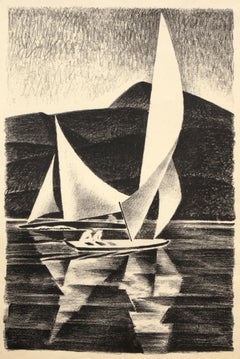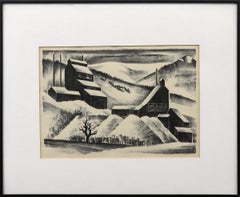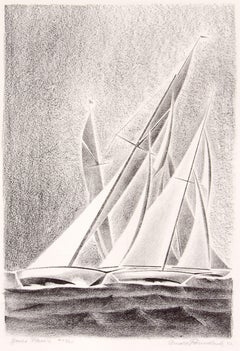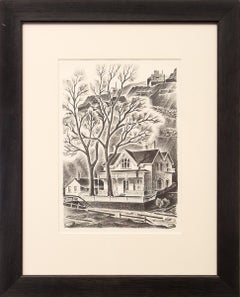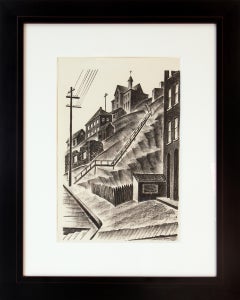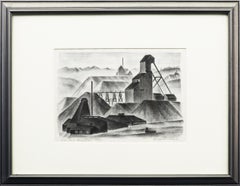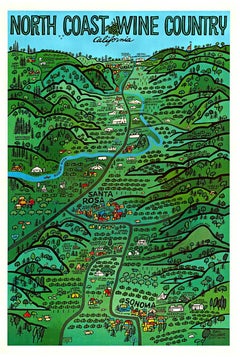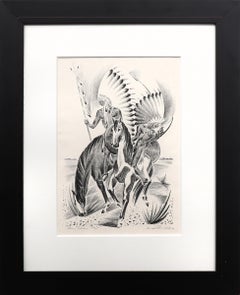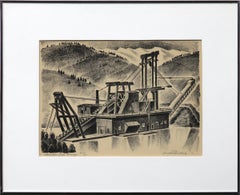Arnold Ronnebeck Art
1885-1947
Modernist sculptor, lithographer and museum administrator, Rönnebeck was a noted member of European and American avant-garde circles in the early twentieth century before settling in Denver, Colorado, in 1926.
After studying architecture at the Royal Art School in Berlin for two years beginning in 1905, he moved to Paris in 1908 to study sculpture with Aristide Maillol and Émile-Antoine Bourdelle. While there he met and befriended American modernist painter, Marsden Hartley, of whom he sculpted a bronze head that was exhibited at the Salon d’Automne in Paris in 1912 and the following year at Hartley’s solo show of paintings at Alfred Stieglitz’s Gallery 291 in New York.
After World War I Rönnebeck traveled in Italy with German writer, Max Sidow, and German poet, Theodor Daubler, doing a series of drawings of Positano and the Amalfi Coast that formed the basis for his lithographs on the subject. The death of his finacée, the young American opera singer Alice Miriam in 1922 and his own family’s increasing financial problems in post-World War I Germany led him to immigrate to the United States in 1923. After living briefly with Miriam’s family in Washington, DC, he moved to New York where he became part of the avant-garde circle around Alfred Stieglitz.
In the summer of 1925, as the guest of Mabel Dodge Luhan, Rönnebeck first saw Taos, New Mexico, which Marsden Hartley had encouraged him to visit. It was there that he met his future wife, Louise Emerson, an easel painter and muralist. A year later they were married in New York before relocating to Denver. He served as director of the Denver Art Museum from 1926 to 1930 where he invited Marsden Hartley to lecture on Cézanne’s art in 1928. Rönnebeck fostered the development of the museum’s collection of American Indian art and the curation of modernist art exhibitions. In addition to his work at the museum, he was professor of sculpture at the University of Denver’s College of Fine and Applied Arts from 1929 to 1935, and wrote a weekly art column in the Rocky Mountain News.
In Colorado, the subject matter of his lithographs became the state’s landscape and its mining towns, as well as Native Americans from the pueblos in neighboring New Mexico. By the early 1930s Colorado’s old mining towns became a popular genre for artists because they were easily accessible, and their architectural components provided a welcome break from the nineteenth-century panoramic landscape tradition and the overwrought cowboy-and-Indian subject matter of the previous generation. As an amateur actor and music enthusiast, Rönnebeck had an additional connection with Central City.
In June 1947, some five months before his death, the Denver Art Museum organized a solo exhibition of his sculptures, watercolors and prints.
© copyright Stan Cuba for David Cook Galleriesto
2
2
2
2
Overall Width
to
Overall Height
to
6
6
6
4
2
3
2
2
1
1
1
6
1
9
29
18
9
8
4
6
6
Artist: Arnold Ronnebeck
Dealer: David Cook Galleries
1930s Black & White Print of Grand Lake Yacht Races in Colorado Mountain Lake
By Arnold Rönnebeck
Located in Denver, CO
This vintage 1930s black and white lithograph by Arnold Ronnebeck (1885-1947), a prominent Colorado artist from the WPA era, beautifully captures the Grand Lake...
Category
1930s American Modern Arnold Ronnebeck Art
Materials
Lithograph
Mine Near Continental Divide – 1930s Winter Landscape of Colorado Mountains
By Arnold Rönnebeck
Located in Denver, CO
This rare 1933 lithograph by renowned modernist artist Arnold Rönnebeck captures a dramatic black-and-white winter scene of a Colorado mountain mine, blanketed in snow. The bold cont...
Category
1930s American Modern Arnold Ronnebeck Art
Materials
Lithograph
1933 Black & White Lithograph of Yacht Races on Grand Lake, Colorado, Sailboats
By Arnold Rönnebeck
Located in Denver, CO
A rare and striking original 1933 black and white lithograph by noted modernist Arnold Rönnebeck (1885–1947), titled Yacht Races, Grand Lake, Colorado. This limited-edition coastal a...
Category
1930s American Modern Arnold Ronnebeck Art
Materials
Lithograph
1930s Black and White Lithograph of House at Gregory Point, Colorado Landscape
By Arnold Rönnebeck
Located in Denver, CO
This original lithograph by renowned modernist Arnold Ronnebeck (1885-1947) depicts a charming home in Gregory Point, near Central City, Colorado. Created during the 1930s, this piec...
Category
1930s American Modern Arnold Ronnebeck Art
Materials
Paper, Lithograph
WPA-Era Central City, Colorado, 1930s Modernist Lithograph, Cityscape 3/25
By Arnold Rönnebeck
Located in Denver, CO
This 1933 lithograph, Central City, Colorado 3/25, by Arnold Rönnebeck, captures the architectural essence of a historic mining town during the Great Depression. Rendered in black an...
Category
1930s American Modern Arnold Ronnebeck Art
Materials
Lithograph
Silver Mine, Russell Gulch, CO (12/25) 1930s American Modern Lithograph Print
By Arnold Rönnebeck
Located in Denver, CO
"Silver Mine, Russell Gulch (12/25)" is a captivating black and white lithograph by American artist Arnold Ronnebeck. The piece features a mining scene in Russell Gulch, Colorado, wi...
Category
1930s American Modern Arnold Ronnebeck Art
Materials
Lithograph
Related Items
Original "American Labor ... Producing for Attack" vintage 1943 poster
Located in Spokane, WA
Original AMERICAN LABOR - PRODUCING FOR ATTACK vintage 1943 poster. Size: 19.5" x 22.25. Professional archival linen backed; ready to frame. War Production Board, Washington D.C.
Original. Lithograph. printed by the US Government...
Category
1940s American Modern Arnold Ronnebeck Art
Materials
Offset
H 27.25 in W 19.5 in D 0.05 in
Original North Coast Wine Country California vintage vineyard travel poster
Located in Spokane, WA
Original North Coast Wine Country California vintage vineyard travel poster. The artist Earl Thollander. Size 24.25” x 30”. Archival linen backed in good condition. Grade A- A repaired tear along the bottom was restored during linen backing and is inconspicuous.
Celebrate Your Passion for Wine: Show off your love for wine culture while honoring California's North Coast’s rich history as one of the world’s premier wine regions. This poster represents the artistry and heritage behind each glass of wine you enjoy.
Capture the Essence of California Wine Culture in 1975
Transport yourself to the golden era of wine-making with this authentic vintage 1975 North Coast Wine Country poster, a must-have for those who love wine, history, and timeless art. Featuring a design that exudes classic California vineyard...
Category
1970s American Modern Arnold Ronnebeck Art
Materials
Lithograph
H 36 in W 24.25 in D 0.3 in
Original Lido 'Pour Vous' vintage 1961 French Cabaret linen backed poster.
By René Gruau
Located in Spokane, WA
Original poster: Lido "Pour Vous"; artist: Rene Gruau (Renato De Zavagli, 1910-2004); size: 15.25 x 23 1/8". Archival linen backed the original Lido Cabaret poster in excellent c...
Category
1960s American Modern Arnold Ronnebeck Art
Materials
Lithograph
H 23.25 in W 15.25 in D 0.1 in
Hand Signed Norman Rockwell "No Swimming" Print
By Norman Rockwell
Located in New York, NY
Norman Rockwell (American, 1894-1978)
No Swimming
Original painting produced 1921, date of this print unknown
Lithograph
Sight: 21 x 18 in.
Framed: 30 x 24 x 1 in.
Signed in plate
Ha...
Category
1920s American Modern Arnold Ronnebeck Art
Materials
Lithograph
Royal Hotel - New Orleans 1920s Depression Art Lithograph in Ink on Paper
Located in Soquel, CA
Royal Hotel - New Orleans 1920s Depression Art Lithograph in Ink on Paper
Dramatic street scene with a man wearing a trench coat and hat by Robert J We...
Category
Late 20th Century American Modern Arnold Ronnebeck Art
Materials
Paper, Lithograph
Charles Locke, McCosh Walk, Princeton University
By Charles Locke
Located in New York, NY
This lithograph is signed in pencil under the image at the lower right. Just above that, in the image, are the artist's initials and the date, 1942.
This well-known walkway on the P...
Category
1940s American Modern Arnold Ronnebeck Art
Materials
Lithograph
Prodigal Son
By Thomas Hart Benton
Located in London, GB
A man raises his hand to his chin, his neck tilted and face turned to look at a dilapidated farmhouse, barely held together by planks of wood and exposed to the elements. Behind him ...
Category
1930s American Modern Arnold Ronnebeck Art
Materials
Lithograph
Mexican Travelers, Modern Lithograph by Millard Sheets
By Millard Sheets
Located in Long Island City, NY
Mexican Travelers by Millard Owen Sheets, American (1907–1989)
Date: Circa 1977
Lithograph on Arches paper, signed and numbered in pencil
Edition o...
Category
1970s American Modern Arnold Ronnebeck Art
Materials
Lithograph
Original Keep These Off The U.S.A., Buy Liberty Bonds vintage WW1 poster
Located in Spokane, WA
Original Keep These Off the U.S.A." buy more Liberty Bonds vintage World War One posters. Archival linen backed in excellent condition, ready to frame. The images shown are of the exact poster you will receive. Grade A- Artist: John Norton. Printed by The Strobridge Litho Co., Cincinnati & New York. Ref: Johnson 21, Rawls 214, Full-size paper, not trimmed 31" x 40.25" in size.
Bend right corner straightened during linen backing and tiny edge repair. Excellent bright colors. Clean, ready to frame.
This poster was part of the Committee on Public Information (CPI) 's broader propaganda campaign to rally American support for the war effort. It shows a pair of boots with red stains, showing blood dripping onto the ground. The German Adler is on the top of each boot and is shown wearing spurs.
The "Keep These Off the USA" poster was created during World War I as part of a broader American propaganda campaign to rally support for the war effort and demonize the enemy, particularly Germany. Propaganda posters...
Category
1910s American Modern Arnold Ronnebeck Art
Materials
Lithograph
H 40.25 in W 31 in D 0.05 in
Original Kaffee-Rahm, Swiss vintage coffee poster
Located in Spokane, WA
Original Swiss Kaffee Rahm Pilatus ; Swiss coffee cream poster. Linen backed. The coffee-colored woman poises with a coffee cup on her head, pouring s...
Category
1950s American Modern Arnold Ronnebeck Art
Materials
Lithograph
Low Tide
Located in San Francisco, CA
This artwork titled "Low Tide" 1943 is an original lithograph by New York artist Julian Edwin Levi, 1900-1982. It is hand signed in pencil by the art...
Category
Mid-20th Century American Modern Arnold Ronnebeck Art
Materials
Lithograph
WITHOUT A NET
By George Scribner
Located in Santa Monica, CA
GEORGE SCHREIBER (1904 – 1977)
WITHOUT A NET c. 1944
Lithograph, signed in pencil lower right. Image 8 7/8 x 13 5/8 inches, sheet 10 5/8 x 15 ½ inches.Edition approximately 250 as p...
Category
1940s American Modern Arnold Ronnebeck Art
Materials
Lithograph
Previously Available Items
Framed 1930s Signed Lithograph 'Plains Indians' (6/75) by Arnold Ronnebeck
By Arnold Rönnebeck
Located in Denver, CO
Original lithograph by Arnold Ronnebeck (1885-1947) titled 'Plains Indians' (6-75) created in 1931. Features two figures on horseback in black and white, signed, dated, titled and numbered in lower margin. Presented in a custom frame with all archival materials measuring 24 1⁄4 x 19 1⁄2 x 1⁄2 inches.
About the Artist:
Born Nassau, Germany 1885
Died Colorado 1947
Modernist sculptor, lithographer and museum administrator, Rönnebeck was a noted member of European and American avant-garde circles in the early twentieth century before settling in Denver, Colorado, in 1926.
In 1908, Rönnebeck moved to Paris to study sculpture. A frequent guest of Gertrude Stein’s Saturday "evenings" in Paris, she described Rönnebeck as "charming and always invited to dinner,”
After the outbreak of World War I in 1914, Rönnebeck returned to Germany where he served as an officer in the German Imperial Army. The death of his finacée, young American opera singer Alice Miriam in 1922 and his own family’s increasing financial problems in post-World War I Germany led him to immigrate to the United States in 1923. He moved to New York where he became part of the avant-garde circle around Alfred Stieglitz.
In New York Rönnebeck began producing Precisionist-style lithographs of the city’s urban landscapes which he termed "living cubism." Through Stieglitz he met Erhard Weyhe head of the Weyhe Gallery who arranged Rönnebeck’s first solo American exhibition in May 1925 at the gallery in New York. Comprising some sixty works – prints, drawings and sculpture – the show subsequently traveled on a thirteen-month tour of major American cities.
In the summer of 1925, as the guest of Mabel Dodge Luhan...
Category
1930s American Modern Arnold Ronnebeck Art
Materials
Archival Paper, Lithograph
H 24.25 in W 19.5 in D 0.5 in
Colorado Gold Dredge, Breckenridge, Signed Black and White Mining Lithograph
By Arnold Rönnebeck
Located in Denver, CO
Lithograph on paper titled 'Colorado Gold Dredge, Breckenridge' by Arnold Ronnebeck (1885-1947) from 1932. Numbered 15/25. Depicted is a gold dredge in Colorado mining town Breckenridge with a mountain landscape in the background. Presented in a custom frame measuring 17 ¼ x 21 ¼ inches. Image size measures 10 ¼ x 14 ¼ inches.
Print is clean and in very good vintage condition - please contact us for a detailed condition report.
Provenance: Estate of Arnold Ronnebeck
Expedited and international shipping is available - please contact us for a quote.
About the Artist:
Modernist sculptor, lithographer and museum administrator, Rönnebeck was a noted member of European and American avant-garde circles in the early twentieth century before settling in Denver, Colorado, in 1926.
After studying architecture at the Royal Art School in Berlin for two years beginning in 1905, he moved to Paris in 1908 to study sculpture with Aristide Maillol and Émile-Antoine Bourdelle. While there he met and befriended American modernist painter, Marsden Hartley, of whom he sculpted a bronze head that was exhibited at the Salon d’Automne in Paris in 1912 and the following year at Hartley’s solo show of paintings at Alfred Stieglitz’s Gallery 291 in New York. A frequent guest of Gertrude Stein’s Saturday "evenings" in Paris, she described Rönnebeck as "charming and always invited to dinner," along with Pablo Picasso, Mabel Dodge (Luhan) and Charles Demuth.
After the outbreak of World War I in 1914, Rönnebeck returned to Germany where he served as an officer in the German Imperial Army on the front lines. Twice wounded, including in the Battle of Marne in France, Kaiser Wilhelm II awarded him the Iron Cross. During the war Hartley fell in love with Rönnebeck’s cousin, Lieutenant Karl von Freyburg, who was killed in combat. As a tribute to Freyburg, Hartley created Portrait of a German Officer (1914) now in the Metropolitan Museum of Art in New York.
After the war Rönnebeck traveled in Italy with German writer, Max Sidow, and German poet, Theodor Daubler, doing a series of drawings of Positano and the Amalfi Coast that formed the basis for his lithographs on the subject. The death of his finacée, the young American opera singer Alice Miriam in 1922 and his own family’s increasing financial problems in post-World War I Germany led him to immigrate to the United States in 1923. After living briefly with Miriam’s family in Washington, DC, he moved to New York where he became part of the avant-garde circle around Alfred Stieglitz. His essay, "Through the Eyes of a European Sculptor," appeared in the catalog for the Anderson Gallery exhibition, "Alfred Stieglitz Presents Seven Americans: 159 Paintings, Photographs & Things, Recent & Never Publicly Shown, by Arthur G. Dove, Marsden Hartley, John Marin, Charles Demuth, Paul Strand, Georgia O’Keeffe, Alfred Stieglitz."
In New York Rönnebeck began producing Precisionist-style lithographs of the city’s urban landscapes which he termed "living cubism." Some of them were reproduced in Vanity Fair magazine. Through Stieglitz he met Erhard Weyhe head of the Weyhe Gallery who, with its director Carl Zigrosser, arranged Rönnebeck’s first solo American exhibition in May 1925 at the gallery in New York. Comprising some sixty works – prints, drawings and sculpture – the show subsequently traveled on a thirteen-month tour of major American cities. Until the end of his life, the gallery represented him, along with other American artists Adolf Dehn, Wanda Gag, Rockwell Kent, J.J. Lankes, Louis Lozowick, Reginald Marsh and John Sloan.
In the summer of 1925, as the guest of Mabel Dodge Luhan, Rönnebeck first saw Taos, New Mexico, which Marsden Hartley had encouraged him to visit. It was there that he met his future wife, Louise Emerson, an easel painter and muralist. A year later they were married in New York before relocating to Denver. He served as director of the Denver Art Museum from 1926 to 1930 where he invited Marsden Hartley to lecture on Cézanne’s art in 1928. Rönnebeck fostered the development of the museum’s collection of American Indian art and the curation of modernist art exhibitions. In addition to his work at the museum, he was professor of sculpture at the University of Denver’s College of Fine and Applied Arts from 1929 to 1935, and wrote a weekly art column in the Rocky Mountain News.
His best known Denver sculptures from the late 1920s in bronze, copper, stone, wood and terra cotta include a reredos, The Epiphany, at St. Martin’s Chapel; The History of Money (six panels) at the Denver National Bank; The Ascension at the Church of Ascension; and the William V. Hodges Family Memorial at Fairmount Cemetery. At the same time he did a series of terra cotta relief panels for La Fonda Hotel in Santa Fe, New Mexico. In the 1930s his bas-relief aluminum friezes of stylized Pueblo and Hopi Indian Kachina masks...
Category
1930s American Modern Arnold Ronnebeck Art
Materials
Paper, Lithograph
H 17.25 in W 21.25 in D 0.75 in
Bucking Bronco, Original Sketch of Horse and Cowboy, Modernist Framed Drawing
By Arnold Rönnebeck
Located in Denver, CO
Graphite on paper drawing by Arnold Ronnebeck of a bucking bronco and cowboy, signed by the artist in the lower right corner. Presented in a custom black frame, outer dimensions measure 22 ⅜ x 18 ⅜ x ¾ inches. Image sight size is 10 ½ x 8 ¾ inches.
Drawing is clean and in very good vintage condition - please contact us for a detailed condition report.
Expedited and international shipping is available - please contact us for a quote.
About the artist:
Modernist sculptor, lithographer and museum administrator, Rönnebeck was a noted member of European and American avant-garde circles in the early twentieth century before settling in Denver, Colorado, in 1926.
After studying architecture at the Royal Art School in Berlin for two years beginning in 1905, he moved to Paris in 1908 to study sculpture with Aristide Maillol and Émile-Antoine Bourdelle. While there he met and befriended American modernist painter, Marsden Hartley, of whom he sculpted a bronze head that was exhibited at the Salon d’Automne in Paris in 1912 and the following year at Hartley’s solo show of paintings at Alfred Stieglitz’s Gallery 291 in New York. A frequent guest of Gertrude Stein’s Saturday "evenings" in Paris, she described Rönnebeck as "charming and always invited to dinner," along with Pablo Picasso, Mabel Dodge (Luhan) and Charles Demuth.
After the outbreak of World War I in 1914, Rönnebeck returned to Germany where he served as an officer in the German Imperial Army on the front lines. Twice wounded, including in the Battle of Marne in France, Kaiser Wilhelm II awarded him the Iron Cross. During the war Hartley fell in love with Rönnebeck’s cousin, Lieutenant Karl von Freyburg, who was killed in combat. As a tribute to Freyburg, Hartley created Portrait of a German Officer (1914) now in the Metropolitan Museum of Art in New York.
After the war Rönnebeck traveled in Italy with German writer, Max Sidow, and German poet, Theodor Daubler, doing a series of drawings of Positano and the Amalfi Coast that formed the basis for his lithographs on the subject. The death of his finacée, the young American opera singer Alice Miriam in 1922 and his own family’s increasing financial problems in post-World War I Germany led him to immigrate to the United States in 1923. After living briefly with Miriam’s family in Washington, DC, he moved to New York where he became part of the avant-garde circle around Alfred Stieglitz. His essay, "Through the Eyes of a European Sculptor," appeared in the catalog for the Anderson Gallery exhibition, "Alfred Stieglitz Presents Seven Americans: 159 Paintings, Photographs & Things, Recent & Never Publicly Shown, by Arthur G. Dove, Marsden Hartley, John Marin, Charles Demuth, Paul Strand, Georgia O’Keeffe, Alfred Stieglitz."
In New York Rönnebeck began producing Precisionist-style lithographs of the city’s urban landscapes which he termed "living cubism." Some of them were reproduced in Vanity Fair magazine. Through Stieglitz he met Erhard Weyhe head of the Weyhe Gallery who, with its director Carl Zigrosser, arranged Rönnebeck’s first solo American exhibition in May 1925 at the gallery in New York. Comprising some sixty works – prints, drawings and sculpture – the show subsequently traveled on a thirteen-month tour of major American cities. Until the end of his life, the gallery represented him, along with other American artists Adolf Dehn, Wanda Gag, Rockwell Kent, J.J. Lankes, Louis Lozowick, Reginald Marsh and John Sloan.
In the summer of 1925, as the guest of Mabel Dodge Luhan, Rönnebeck first saw Taos, New Mexico, which Marsden Hartley had encouraged him to visit. It was there that he met his future wife, Louise Emerson, an easel painter and muralist. A year later they were married in New York before relocating to Denver. He served as director of the Denver Art Museum from 1926 to 1930 where he invited Marsden Hartley to lecture on Cézanne’s art in 1928. Rönnebeck fostered the development of the museum’s collection of American Indian art and the curation of modernist art exhibitions. In addition to his work at the museum, he was professor of sculpture at the University of Denver’s College of Fine and Applied Arts from 1929 to 1935, and wrote a weekly art column in the Rocky Mountain News.
His best known Denver sculptures from the late 1920s in bronze, copper, stone, wood and terra cotta include a reredos, The Epiphany, at St. Martin’s Chapel; The History of Money (six panels) at the Denver National Bank; The Ascension at the Church of Ascension; and the William V. Hodges Family Memorial at Fairmount Cemetery. At the same time he did a series of terra cotta relief panels for La Fonda Hotel in Santa Fe, New Mexico. In the 1930s his bas-relief aluminum friezes of stylized Pueblo and Hopi Indian Kachina masks...
Category
20th Century American Modern Arnold Ronnebeck Art
Materials
Graphite
H 22.5 in W 18.5 in D 0.75 in
Summer Afternoon, Taos, New Mexico, 1920s Modern Watercolor Mountain Landscape
By Arnold Rönnebeck
Located in Denver, CO
Watercolor on paper. Image size is 7 ¾ x 10 ¼ inches, dimensions with mat measure 16 ¼ x 18 ¼ inches. This piece is unframed, housed in an archival mat. Framed pictures are mock-ups and custom framing options are available.
Painting is clean and in very good vintage condition - please contact us for a complete condition report.
Expedited and international shipping is available - please contact us for a quote.
Provenance: Estate of Arnold Ronnebeck
About the artist:
Modernist sculptor, lithographer and museum administrator, Rönnebeck was a noted member of European and American avant-garde circles in the early twentieth century before settling in Denver, Colorado, in 1926.
After studying architecture at the Royal Art School in Berlin for two years beginning in 1905, he moved to Paris in 1908 to study sculpture with Aristide Maillol and Émile-Antoine Bourdelle. While there he met and befriended American modernist painter, Marsden Hartley, of whom he sculpted a bronze head that was exhibited at the Salon d’Automne in Paris in 1912 and the following year at Hartley’s solo show of paintings at Alfred Stieglitz’s Gallery 291 in New York. A frequent guest of Gertrude Stein’s Saturday "evenings" in Paris, she described Rönnebeck as "charming and always invited to dinner," along with Pablo Picasso, Mabel Dodge (Luhan) and Charles Demuth.
After the outbreak of World War I in 1914, Rönnebeck returned to Germany where he served as an officer in the German Imperial Army on the front lines. Twice wounded, including in the Battle of Marne in France, Kaiser Wilhelm II awarded him the Iron Cross. During the war Hartley fell in love with Rönnebeck’s cousin, Lieutenant Karl von Freyburg, who was killed in combat. As a tribute to Freyburg, Hartley created Portrait of a German Officer (1914) now in the Metropolitan Museum of Art in New York.
After the war Rönnebeck traveled in Italy with German writer, Max Sidow, and German poet, Theodor Daubler, doing a series of drawings of Positano and the Amalfi Coast that formed the basis for his lithographs on the subject. The death of his finacée, the young American opera singer Alice Miriam in 1922 and his own family’s increasing financial problems in post-World War I Germany led him to immigrate to the United States in 1923. After living briefly with Miriam’s family in Washington, DC, he moved to New York where he became part of the avant-garde circle around Alfred Stieglitz. His essay, "Through the Eyes of a European Sculptor," appeared in the catalog for the Anderson Gallery exhibition, "Alfred Stieglitz Presents Seven Americans: 159 Paintings, Photographs & Things, Recent & Never Publicly Shown, by Arthur G. Dove, Marsden Hartley, John Marin, Charles Demuth, Paul Strand, Georgia O’Keeffe, Alfred Stieglitz."
In New York Rönnebeck began producing Precisionist-style lithographs of the city’s urban landscapes which he termed "living cubism." Some of them were reproduced in Vanity Fair magazine. Through Stieglitz he met Erhard Weyhe head of the Weyhe Gallery who, with its director Carl Zigrosser, arranged Rönnebeck’s first solo American exhibition in May 1925 at the gallery in New York. Comprising some sixty works – prints, drawings and sculpture – the show subsequently traveled on a thirteen-month tour of major American cities. Until the end of his life, the gallery represented him, along with other American artists Adolf Dehn, Wanda Gag, Rockwell Kent, J.J. Lankes, Louis Lozowick, Reginald Marsh and John Sloan.
In the summer of 1925, as the guest of Mabel Dodge Luhan, Rönnebeck first saw Taos, New Mexico, which Marsden Hartley had encouraged him to visit. It was there that he met his future wife, Louise Emerson, an easel painter and muralist. A year later they were married in New York before relocating to Denver. He served as director of the Denver Art Museum from 1926 to 1930 where he invited Marsden Hartley to lecture on Cézanne’s art in 1928. Rönnebeck fostered the development of the museum’s collection of American Indian art and the curation of modernist art exhibitions. In addition to his work at the museum, he was professor of sculpture at the University of Denver’s College of Fine and Applied Arts from 1929 to 1935, and wrote a weekly art column in the Rocky Mountain News.
His best known Denver sculptures from the late 1920s in bronze, copper, stone, wood and terra cotta include a reredos, The Epiphany, at St. Martin’s Chapel; The History of Money (six panels) at the Denver National Bank; The Ascension at the Church of Ascension; and the William V. Hodges Family Memorial at Fairmount Cemetery. At the same time he did a series of terra cotta relief panels for La Fonda Hotel in Santa Fe, New Mexico. In the 1930s his bas-relief aluminum friezes of stylized Pueblo and Hopi Indian Kachina masks...
Category
1920s American Modern Arnold Ronnebeck Art
Materials
Watercolor
Mine Near Contintental Divide, Colorado, 1930s Black & White Original Lithograph
By Arnold Rönnebeck
Located in Denver, CO
Mine Near Contintental Divide, Colorado, original vintage 1933 black and white lithograph by WPA era modernist, Arnold Ronnebeck (1885-1947), number 22 in an edition of 25 prints. M...
Category
1930s American Modern Arnold Ronnebeck Art
Materials
Lithograph
H 10.25 in W 14 in D 0.07 in
Casa Luhan, Adobe Home of Mabel Dodge Luhan, Taos, New Mexico, Landscape
By Arnold Rönnebeck
Located in Denver, CO
Casa Luhan (Home of Mabel Dodge Luhan, Taos, New Mexico) vintage 1925 modernist original drawing by Arnold Ronnebeck (1885-1947), southwestern landsc...
Category
1920s American Modern Arnold Ronnebeck Art
Materials
Graphite
H 19.5 in W 23.5 in D 0.5 in
Grand Lake (Yacht Races, Colorado)
By Arnold Rönnebeck
Located in Denver, CO
Sailboats on Grand Lake in Colorado, 1932. Number 8 in an edition of 25. Presented in a custom frame with all archival materials; outer dimensions measure...
Category
1930s American Modern Arnold Ronnebeck Art
Materials
Lithograph
Grand Lake (Colorado)
By Arnold Rönnebeck
Located in Denver, CO
Sailboats on Colorado's Grand Lake. Created in 1932, this is number 8 in an edition of only 25 prints. Custom frame with all archival materials; framed di...
Category
1930s American Modern Arnold Ronnebeck Art
Materials
Etching
Arnold Ronnebeck art for sale on 1stDibs.
Find a wide variety of authentic Arnold Ronnebeck art available for sale on 1stDibs. You can also browse by medium to find art by Arnold Ronnebeck in lithograph, paper, graphite and more. Much of the original work by this artist or collective was created during the 20th century and is mostly associated with the modern style. Not every interior allows for large Arnold Ronnebeck art, so small editions measuring 8 inches across are available. Customers who are interested in this artist might also find the work of Paul Landacre, Lawrence Wilbur, and Rockwell Kent. Arnold Ronnebeck art prices can differ depending upon medium, time period and other attributes. On 1stDibs, the price for these items starts at $1,225 and tops out at $28,000, while the average work can sell for $2,515.
